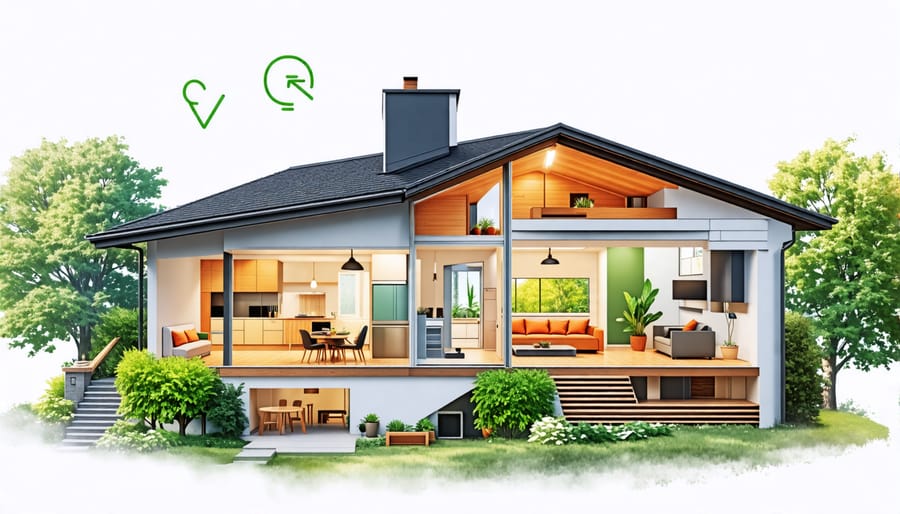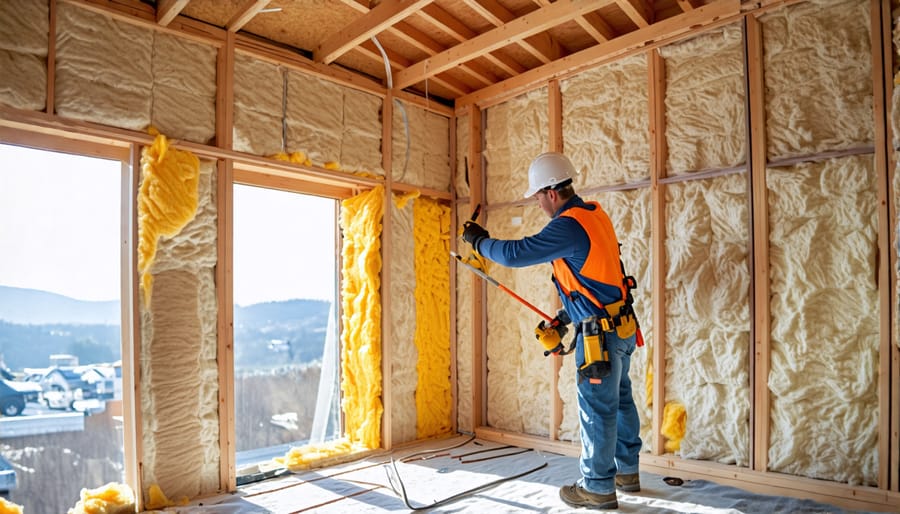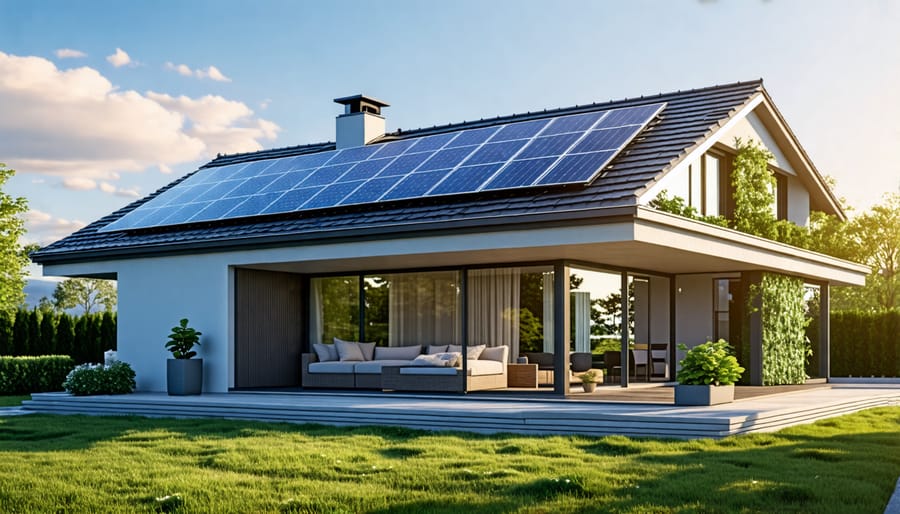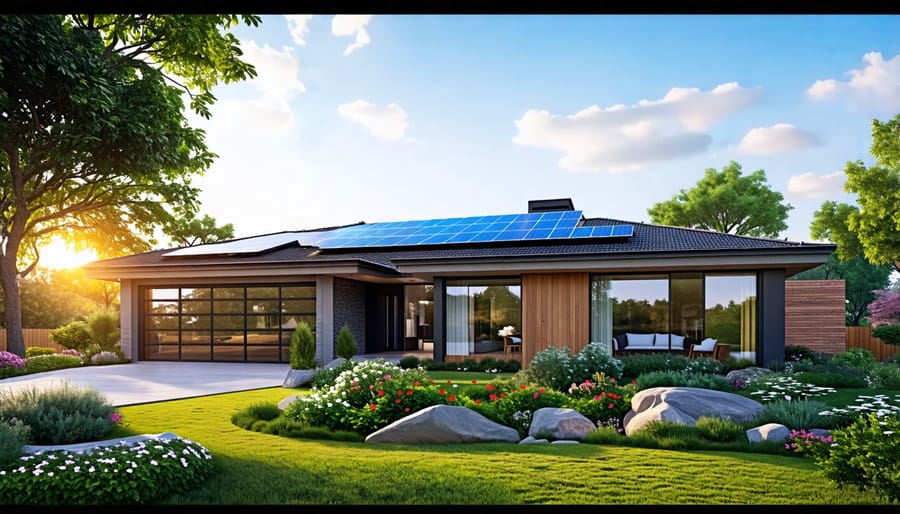Design your home with passive solar principles to harness the sun’s energy for heating and cooling. Incorporate high-performance insulation and air sealing to minimize thermal bridging and air leakage. Install energy-efficient windows and doors with low-E coatings and insulated frames to reduce heat transfer. Utilize efficient HVAC systems like heat pumps, ERVs, and smart thermostats to optimize comfort and minimize energy waste.
Start with Smart Design

Passive Solar Techniques
Passive solar design harnesses the sun’s energy to heat and illuminate a home naturally. South-facing windows allow low-angle winter sun to penetrate deep into the house, warming thermal mass materials like concrete, stone, or tile that absorb and store heat. These materials radiate warmth back into the space at night, stabilizing temperature. In summer, strategically placed overhangs, awnings, or deciduous trees shade windows from intense sunlight, reducing cooling loads. Proper window sizing, placement, and glazing optimize solar gain and minimize heat loss. Light-colored interior surfaces reflect daylight, enhancing natural illumination. Passive solar techniques, combined with efficient insulation, air sealing, and ventilation, create a comfortable, energy-saving home that works in harmony with the sun’s natural cycles.

Invest in High-Performance Insulation
Investing in high-performance insulation is crucial for achieving an energy-efficient home. The effectiveness of insulation is measured by its R-value, which indicates its resistance to heat flow. Higher R-values translate to better insulation performance. For walls, consider using spray foam insulation, which offers R-values ranging from R-3.6 to R-6.5 per inch, depending on the type. Fiberglass batts are another popular option, with R-values between R-2.9 and R-3.8 per inch. Mineral wool provides excellent fire resistance and sound insulation, with R-values around R-3.0 to R-3.3 per inch.
In attics, blown-in cellulose or loose-fill fiberglass insulation is highly effective, with R-values of R-3.2 to R-3.8 per inch. These materials conform to irregular spaces and provide consistent coverage. For floors, rigid foam board insulation, such as extruded polystyrene (XPS) or expanded polystyrene (EPS), offers R-values of R-4 to R-5 per inch. These boards can be installed beneath the subfloor for optimal efficiency.
When insulating foundations, extruded polystyrene (XPS) is an excellent choice due to its moisture resistance and high R-value of R-5 per inch. Polyisocyanurate (polyiso) boards are another option, with R-values up to R-6.5 per inch. Proper air sealing is essential to prevent air leaks and maximize the effectiveness of insulation. Use spray foam or caulk to seal gaps around windows, doors, and penetrations.
To determine the recommended insulation levels for your climate zone, consult the International Energy Conservation Code (IECC) or the U.S. Department of Energy’s insulation guidelines. By investing in high-performance insulation and proper installation techniques, you can significantly reduce heat transfer, improve comfort, and lower energy costs in your energy-efficient home.
Opt for Energy-Efficient Windows
When selecting windows for an energy-efficient home, it’s crucial to compare various types and features. Low-E (low-emissivity) coatings minimize heat transfer by reflecting infrared light, keeping homes cooler in summer and warmer in winter. Gas fills, such as argon or krypton, between window panes further reduce heat conduction. Double or triple-pane windows provide increased insulation compared to single-pane options.
ENERGY STAR ratings are a reliable guide when choosing energy-efficient windows. These ratings are based on specific climate zones, ensuring that windows are optimized for the local environment. In colder regions, windows with a lower U-factor are ideal, as they provide better insulation. For hotter climates, windows with a lower Solar Heat Gain Coefficient (SHGC) are preferable to minimize heat gain from the sun.
When selecting windows, consider the frame material as well. Fiberglass, vinyl, and wood frames offer better insulation than aluminum. Proper installation is equally important to ensure optimal performance and prevent air leaks. Consult with experienced professionals to determine the best window type and installation method for your specific project and climate.
Investing in energy-efficient windows not only enhances comfort but also leads to significant long-term energy savings. While initial costs may be higher, the reduced energy consumption and potential for smaller HVAC systems can offset the expense over time. By carefully evaluating window options and prioritizing energy efficiency, you can create a home that is both comfortable and environmentally responsible.
Seal Air Leaks
Air sealing is a critical step in building an energy-efficient home, as it prevents conditioned air from escaping and unwanted outdoor air from entering. To identify leaks, conduct a thorough visual inspection and use diagnostic tools like a blower door test or infrared camera. Common areas to check include doors, windows, electrical outlets, and ductwork.
For doors and windows, apply weatherstripping around frames and install door sweeps to seal gaps. Use caulk to fill any cracks or openings in the surrounding walls. Electrical outlets and switch plates can be sealed with foam gaskets behind the cover plates. Recessed lighting fixtures should be rated as airtight and insulation contact (IC) rated to prevent air leakage into the attic.
Seal ductwork using mastic sealant or metal tape, paying close attention to connections at vents, registers, and the air handler unit. Avoid using standard duct tape, as it can degrade over time. Insulate ducts in unconditioned spaces like attics, crawl spaces, or garages to minimize heat loss.
By properly air sealing your home, you can significantly reduce energy waste, improve comfort, and create a healthier indoor environment. Consult with energy efficiency professionals to ensure your home is adequately sealed and to identify any additional opportunities for improvement.
Choose Efficient HVAC Systems
When building an energy-efficient home, selecting the right heating, ventilation, and air conditioning (HVAC) systems is crucial. High-efficiency HVAC options can significantly reduce energy consumption while maintaining a comfortable indoor environment. Heat pumps are an excellent choice, as they efficiently transfer heat from one place to another, providing both heating and cooling. Geothermal systems take advantage of the stable temperatures underground, using the earth as a heat source in winter and a heat sink in summer. These systems can achieve substantial energy savings compared to traditional HVAC units.
Another approach to optimize HVAC efficiency is through zoned temperature control. By dividing the home into separate zones with individual thermostats, homeowners can heat or cool specific areas as needed, avoiding energy waste in unoccupied rooms. Smart thermostats with programmable settings and remote access further enhance the precision and convenience of temperature control.
When selecting HVAC equipment, look for models with high energy efficiency ratings, such as Energy Star certification. Regular maintenance, including cleaning or replacing air filters, ensuring proper refrigerant levels, and sealing ductwork, is essential to maintain optimal system performance and efficiency over time. Consulting with experienced HVAC professionals can help determine the most suitable and efficient solutions tailored to the home’s specific needs and climate. By investing in efficient HVAC systems and implementing smart control strategies, homeowners can significantly reduce their energy bills while ensuring a comfortable and sustainable living environment.
Upgrade to Energy-Saving Appliances
Upgrading to ENERGY STAR certified appliances is a vital step in creating an energy-efficient home. These appliances have been rigorously tested and verified to consume less energy than standard models, resulting in significant electricity savings over time. When selecting new appliances, prioritize those with the ENERGY STAR label to ensure optimal performance and efficiency.
Key appliances to consider upgrading include refrigerators, dishwashers, and laundry machines. ENERGY STAR certified refrigerators use advanced compressors, improved insulation, and more precise temperature controls to reduce energy consumption by up to 35% compared to conventional models. Similarly, ENERGY STAR dishwashers employ innovative technologies like soil sensors and enhanced rack designs to minimize water and electricity usage while delivering superior cleaning results.
When it comes to laundry, opting for an ENERGY STAR certified washer and dryer can make a substantial impact on your home’s energy efficiency. These machines often feature larger capacities, allowing you to wash more clothes in fewer loads, and utilize advanced moisture-sensing technology to prevent overdrying and conserve energy. By upgrading to ENERGY STAR appliances throughout your home, you can significantly reduce your electricity bills and contribute to a more sustainable future without compromising on performance or convenience.
Install Smart Lighting and Controls
Installing smart lighting and controls is a highly effective strategy for minimizing wasted energy in a home. LED lighting, known for its superior energy efficiency and longevity, should be the primary choice for all fixtures. Dimmer switches allow for precise control over brightness levels, reducing electricity consumption when full illumination is unnecessary. Timers and occupancy sensors further optimize lighting energy use by automatically switching off lights in unoccupied spaces or during daylight hours.
Smart home systems take lighting control to the next level, enabling easy management through user-friendly interfaces on smartphones or tablets. These systems allow for remote control, scheduling, and customization of lighting scenes for various activities or moods. By integrating lighting with other smart home features like window shades and HVAC, even greater energy savings can be achieved.
When selecting smart lighting and control products, opt for those with proven energy efficiency certifications, such as ENERGY STAR or Title 24 compliance. Proper installation and commissioning by qualified professionals ensure optimal performance and energy savings. With the right combination of efficient lighting technology and intelligent controls, homeowners can significantly reduce their lighting energy consumption while enjoying enhanced convenience and comfort.

Harness Renewable Energy
Harnessing renewable energy is a key strategy for building an energy-efficient home. Rooftop solar panels are a popular option, converting sunlight into electricity to power your home. Solar water heaters use the sun’s energy to heat water, reducing reliance on traditional water heaters. Small wind turbines can also generate electricity, especially in areas with consistent wind speeds.
While upfront costs for these technologies can be significant, many jurisdictions offer incentives like tax credits, grants, or rebates to offset expenses. Over time, the energy savings from renewables can provide a strong return on investment. Conduct a thorough cost-benefit analysis and consult with experienced professionals to determine the most suitable renewable energy solutions for your project.
Incorporating renewable energy not only reduces ongoing energy costs but also contributes to a more sustainable and environmentally friendly home. As technology advances and costs decrease, harnessing renewable energy is becoming an increasingly viable and attractive option for energy-efficient home construction.
Implement Water-Saving Strategies
Conserving water resources is an essential aspect of building an energy-efficient home. Low-flow fixtures, such as faucets, showerheads, and toilets, can significantly reduce water consumption without compromising performance. Native landscaping, which involves selecting plants adapted to the local climate, minimizes the need for irrigation and maintains a beautiful, low-maintenance outdoor space. Rainwater harvesting systems collect and store rainwater for non-potable uses like watering plants or flushing toilets, lessening the demand on municipal water supplies. Greywater recycling, which repurposes water from sinks, showers, and washing machines for irrigation, further optimizes water usage. By implementing these water-saving strategies, homeowners can reduce their environmental impact, lower utility bills, and contribute to the overall efficiency of their homes. Embracing water conservation techniques not only complements energy-saving measures but also demonstrates a commitment to sustainability and responsible resource management in the built environment.
Partner with Skilled Professionals
Constructing an energy-efficient home requires expertise and collaboration. To ensure your project meets the highest standards of sustainability and performance, it’s essential to partner with skilled professionals who specialize in green building practices. Experienced contractors can help you navigate the complexities of energy-efficient construction, from selecting the right materials to implementing advanced building techniques. Additionally, energy auditors can assess your home’s energy consumption and identify areas for improvement, while green building consultants provide valuable insights into sustainable design strategies and cutting-edge technologies. By assembling a team of knowledgeable experts, you can ensure that your home achieves optimal energy efficiency, reduces its environmental impact, and provides a comfortable, healthy living space for years to come. Don’t hesitate to seek out the guidance and support of these professionals throughout your building journey.
Conclusion
Building an energy-efficient home is an investment that pays off in lower utility bills, increased comfort, and a reduced environmental footprint. By implementing smart design principles, using energy-efficient materials and appliances, and incorporating renewable energy systems, you can create a home that is both sustainable and cost-effective. While the initial costs may be higher than traditional construction, the long-term savings and benefits make it a worthwhile investment. As energy costs continue to rise and environmental concerns grow, building an energy-efficient home is not only a wise financial decision but also a responsible choice for the planet. By taking action now, you can enjoy the benefits of an energy-efficient home for years to come and contribute to a more sustainable future for generations to come.

